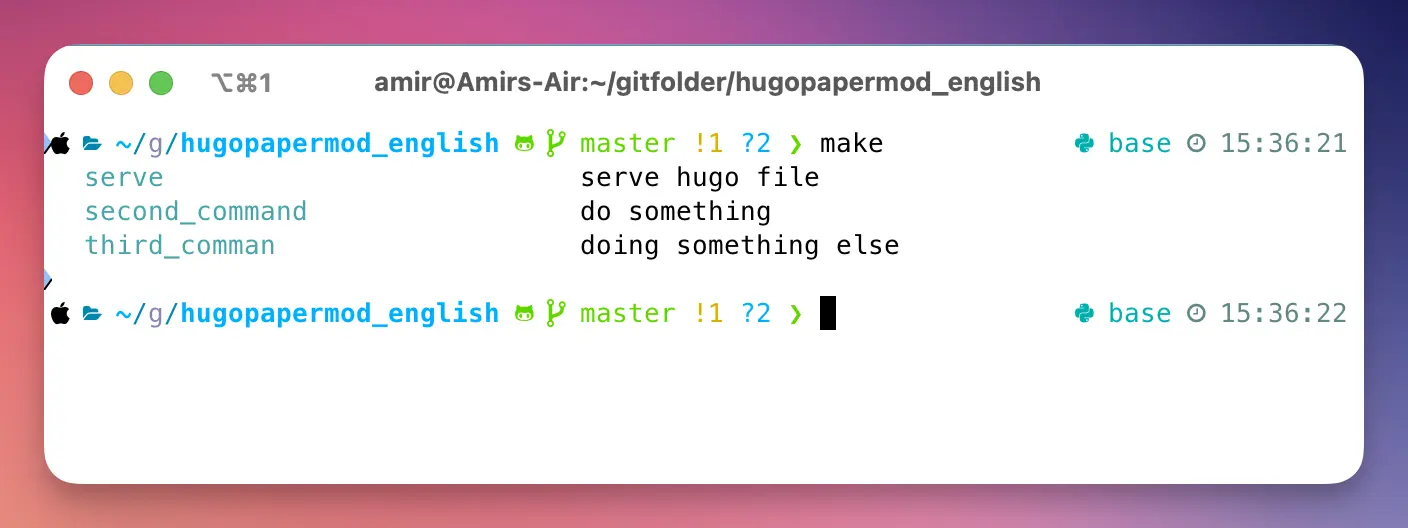Makefiles are one of the most useful tools I’ve been working with. I can say that it can be useful for lots of projects (with any language).
What is Makefile?
Makefiles are essentially a place where you can store your most frequently used commands in one place. They make repetitive tasks easier by creating short commands.
Let’s take a look at sample file:
install_packages:
pip install -r requirements.txt
generate_deps:
pip-compile requirements.in -o requirements.txt
docs:
pdoc --html --force --output-dir docs common
The way to execute this targets would be using make generate_deps or make docs. By default make command will search for a file named Makefile (with no extension) to run your commands.
The commands here would really depend on your project at hand. The good thing, is that you can find them at every project.
Real Makefile Usecase
Previously, I used to train object detection models to detect something. Let’s look at a more real use case of Makefile:
update: ## pull git updates
git pull
tensorboard: ## run tensorboard
tensorboard --logdir runs/train --port 6006
workers = 1
device = 0
batch = 30
train_yolov5m: ## yolov5m without 3dim data
git checkout sampler
git pull
python train.py \
--img-size 512 \
--weights /data/weights/last.pt \
--data /data/database.yaml \
--hyp /data/hyps/hyp_normal_yolov5m.yaml \
--epochs 200 --batch-size 60 \
--device $(device) --save-period 5 \
--workers $(workers)
train_yolov5m3d_midlabel: ## train yolov5 middle-sized mode
git checkout sampler_aneurysm
git pull
python train.py \
--img-size 1024 \
--weights /data/weights/last.pt \
--data /data/database.yaml \
--hyp /data/hyps/hyp-3d_yolov5m.yaml \
--epochs 200 --batch-size 20 \
--device $(device) --save-period 5 \
--workers $(workers)
version=last
val_yolov5s_midlabel: ##validate yolov5s_midlabel
git checkout sampler_aneurysm
git pull
python val.py \
--weights /data/weights/$(version)$.pt \
--data /data/database.yaml \
--batch-size $(batch) --device $(device)\
--img-size 512 --task $(task) \
--save-txt --workers $(workers)
Seriously. Who on their right mind would like to run commands like this? And It might get more complicated as time goes!
If I don’t do that, I should remember that every time I need to switch git branch and provide the necessary arguments for train module and what not. You can see that It reduces a lot of pain.
Use of Variables in Makefiles
You may have seen that I’ve used variables in my Makefile. It is actually a very common way to make it more flexible.
To define them, you can just write them in yaml file:
first_variable=value1
second_variable=value2
Let’s see a simplified usecase:
port=1313
serve: ## serve hugo file
rm -rf public/
hugo serve --port $(port)
This way, the default port is 1313. If you want to change it, you can use:
make server port=1010
You may also want to look at the Real Makefile Usecase above to see how I have used variables.
Makefile help
Makefiles have one problem. In order to see what commands you can use, you should look inside them.
There is also a solution to this problem:
help:
@egrep -h '\s##\s' $(MAKEFILE_LIST) | awk 'BEGIN {FS = ":.*?## "}; {printf "\033[36m %-30s\033[0m %s\n", $$1, $$2}'
serve: ## serve hugo file
rm -rf public/
hugo serve
second_command: ## do something
echo "I am doing something"
third_comman: ## doing something else
echo "I am doing something else"
Adding this help target helps you see what targets you have inside you Makefile. This way when you type make, you would see something like this:

Things to consider
Each makefile command runs on a completely separate shell. So, it doesn’t access anything in your shell. This includes your environment variables you have set or python virtual environment you have activated.
For example, if you are using Conda to separate your different environments, you have to add this command to every target in makefile. So, it would look like this:
SHELL = /bin/bash
CONDA_ACTIVATE = source $$(conda info --base)/etc/profile.d/conda.sh ; conda activate ; conda activate
.PHONY: install
install: ## install yolov5 dependencies
$(CONDA_ACTIVATE) yolov5
pip install -r requirements.txt
tensorboard: ## run tensorboard
$(CONDA_ACTIVATE) yolov5
tensorboard --logdir runs/train --port 6006
Also, don’t forget to add .phony to you makefile targets (Why this is the case). It is not necessary most of the time. For example, If you have a file named install in the same directory as Makefile above, It wouldn’t know which command it should execute. The file or the target! Dummy Makefile!
Also, here a great point about using Makefiles. I’ve came across it multiple times. So be aware ( Reference)
The single biggest piece of advice I can give for Make is to make sure your text editor uses real tabs in Makefiles. My personal preference for everything is spaces (mostly a habit learned from Python’s PEP 8), but Make doesn’t honour spaces for indentation - only tabs.
Despite being an obvious usability hole, this has never been fixed. Exacerbating the issue is the poor error message given upon encountering a space-indented line in Make:
Makefile:2: *** missing separator. Stop.Make is ubiquitous and fairly easy to use, but it’s warts like this that remind you that it is fundamentally a build system from the far past.
Starting Point
In fact whenever I want to start a new Makefile, I just copy these stuff and start from here:
.ONESHELL:
SHELL = /bin/bash
.PHONY: help
help:
@egrep -h '\s##\s' $(MAKEFILE_LIST) | awk 'BEGIN {FS = ":.*?## "}; {printf "\033[36m %-30s\033[0m %s\n", $$1, $$2}'
.PHONY: first_command
first_command: ## documentation of first_command
echo "OK Guys"
Good Luck!
References
- makefiles: the problem: This great tutorial from CalmCode would also showcase this abilities in an intuitive way.